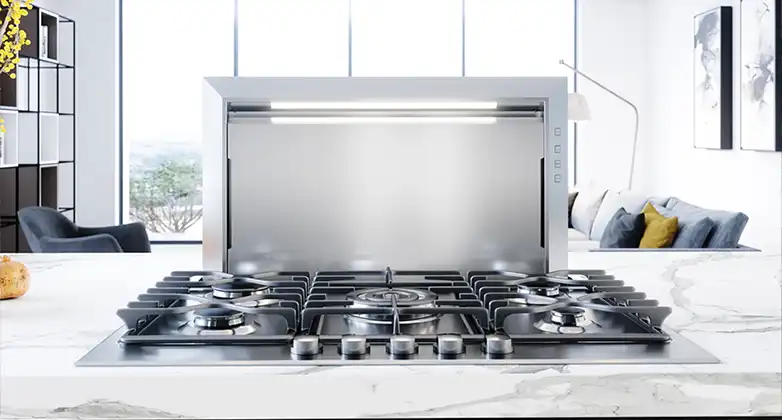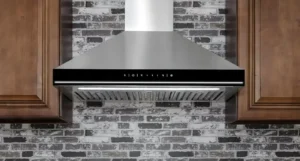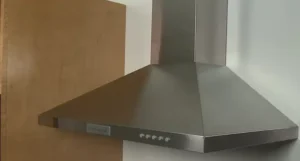Yes, it is possible to install a range hood to vent downwards. This installation method is often referred to as a “downdraft range hood” or a “downward venting range hood.”
Range hoods, also known as kitchen exhaust hoods or extractor hoods, play a crucial role in maintaining a clean and healthy kitchen environment by removing smoke, steam, grease, and odors generated during cooking. Typically, range hoods are installed to vent pollutants upward and out of the kitchen through a duct system that leads to the exterior of the building.
However, some homeowners and designers may wonder whether it’s possible to install a range hood to vent downwards. In this post, we will explore the concept of downward venting for range hoods, when it might be appropriate, its advantages, and disadvantages, and answer frequently asked questions on the topic.

When You Might Consider a Downdraft Range Hood?
Kitchen Island
One of the most common scenarios where a downdraft range hood might be considered is when you have a kitchen island with a cooktop or range installed in it. In such cases, installing a traditional overhead hood may not be feasible or aesthetically desirable, making a downdraft option more appealing.
Open Kitchen Designs
In open-concept kitchen designs where there is no wall space for a traditional overhead hood, a downdraft range hood can be a practical choice to maintain an unobstructed view and clean lines in the kitchen.
Aesthetics
Some homeowners prefer the clean and minimalistic look of downdraft hoods as they do not disrupt the visual flow of the kitchen with bulky overhead units.
Ventilation Challenges
In certain kitchen layouts or buildings with restrictions on exterior ductwork, a downdraft range hood may offer a solution to address ventilation challenges.
Advantages of Downdraft Range Hoods
Space-Saving Design
Downdraft range hoods are an excellent choice when space is limited, or you want to maintain a sleek and open kitchen design. They can be installed flush with the countertop when not in use, maximizing workspace.
Aesthetics
These hoods provide a clean and minimalist appearance, as they are hidden when not in operation, contributing to a streamlined and unobtrusive kitchen design.
Suitable for Islands
Downdraft range hoods are a practical option for kitchen islands, whereas traditional overhead hoods might not be feasible due to a lack of wall space or aesthetic preferences.
Efficient Ventilation
When properly installed and maintained, downdraft hoods can effectively capture and remove cooking byproducts, ensuring a clean and odor-free kitchen environment.
Versatility
Many downdraft range hoods come with adjustable fan speeds and can be used for both vented and ductless operation, offering installation flexibility.
Disadvantages of Downdraft Range Hoods
Limited Capture Area
Downdraft hoods have a limited capture area compared to overhead hoods, which can make them less effective at capturing smoke, steam, and odors, especially when cooking with multiple burners or high heat.
Noise Levels
In some cases, downdraft range hoods can be noisier compared to overhead hoods, as they need to work harder to draw air down and away from the cooking surface.
Installation Complexity
Installing a downdraft range hood can be more complex and expensive, as it requires modifications to the countertop and cabinetry. Professional installation is often necessary.
Maintenance
Downdraft hoods may require more frequent cleaning and maintenance due to their proximity to the cooking surface and the potential for grease buildup.
Performance Variability
The effectiveness of a downdraft range hood can vary depending on factors such as the cooking equipment, cookware used, and the specific hood model. Some may perform better than others.
Frequently Asked Questions (FAQs)
Are downdraft range hoods as effective as traditional overhead hoods?
Downdraft range hoods can be effective at capturing and removing cooking byproducts, but their effectiveness may be somewhat lower than traditional overhead hoods. The efficiency of a downdraft hood depends on factors such as its design, the cooking equipment, and the proximity of the cooking surface to the hood.
Can I install a downdraft range hood in any kitchen?
Downdraft range hoods are best suited for specific kitchen layouts, such as those with kitchen islands or in open-concept designs where traditional overhead hoods may not be practical. However, they may not be the ideal choice for all kitchen configurations.
What are the maintenance requirements for downdraft range hoods?
Downdraft range hoods, like all kitchen ventilation systems, require regular maintenance. This includes cleaning the filters, ductwork, and the fan. Proper maintenance ensures the hood’s continued efficiency and longevity.
Are downdraft range hoods more expensive than traditional hoods?
Downdraft range hoods can be more expensive than traditional overhead hoods due to the additional complexity involved in their installation. The cost may include modifications to the countertop and cabinetry, as well as professional installation.
Can downdraft range hoods be used for both vented and ductless operation?
Yes, many downdraft range hoods offer the option of both vented (ducted) and ductless (recirculating) operation. This provides installation flexibility and allows homeowners to choose the most suitable ventilation method for their kitchen.
Are downdraft range hoods loud?
The noise level of a downdraft range hood can vary depending on the specific model and its fan speed. Some downdraft hoods can be noisier than traditional overhead hoods, especially when operating at higher fan speeds.
Do downdraft range hoods have built-in lighting?
Many downdraft range hoods come with built-in lighting to illuminate the cooking surface. This lighting serves a dual purpose, improving visibility while cooking and adding to the overall aesthetics of the kitchen.
To Sum it Up
Downdraft range hoods provide a practical solution for kitchens where traditional overhead hoods may not be feasible or aesthetically desirable. They offer space-saving design, and a minimalist appearance, and are particularly well-suited for kitchen islands and open-concept layouts. However, it’s important to consider the potential disadvantages, such as limited capture area and noise levels, when choosing a downdraft hood for your kitchen.
Ultimately, the choice between a downdraft range hood and a traditional overhead hood should be based on your kitchen layout, ventilation needs, and design preferences. If you are unsure which option is best for your kitchen, consulting with a professional kitchen designer or ventilation expert can help you make an informed decision and ensure that your kitchen remains a clean, comfortable, and enjoyable space for cooking and dining.



